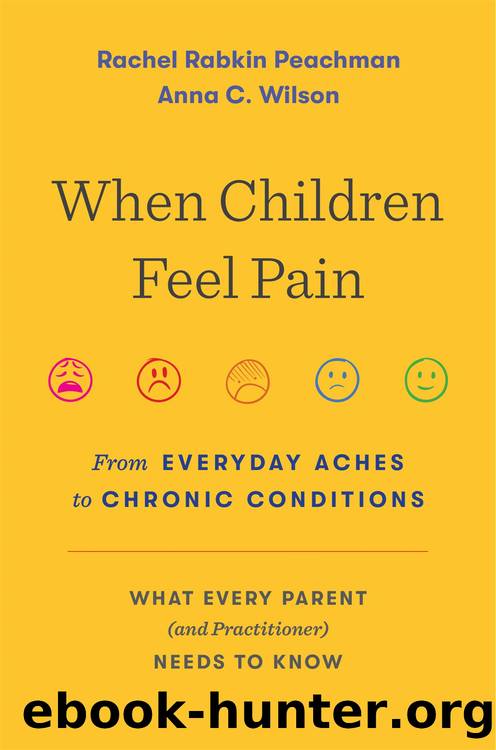When Children Feel Pain by Unknown

Author:Unknown
Language: eng
Format: epub
Publisher: Harvard University Press
What to do when an injury happens:
If an injury does develop, seek medical care, and make sure your child takes the time off thatâs needed to truly recover. Often this will include physical therapy. âI always emphasize the value of rest,â says Barbara Bergin, an orthopedic surgeon in Austin and cofounder of Texas Orthopedics, Sports, and Rehabilitation Associates. âNobody wants to rest. They want to take pain-relieving medications and be able to go to school or work. But I suggest that, if you need a pain pill, then you should stay home and rest. With children, I focus on lots of ice, elevation, and TLC.â
If surgery is required, help your child be realistic about the amount of time it means out of the game and find other ways to stay busy. Dr. Bergin, whose own son was sidelined from football due to serious injuries, advises other young athletes to âdo something else that gets your focus off of the sadness of your injuryâwhether thatâs a hobby, volunteering, or anything else you enjoy.â And, she adds, âif youâre planning to return to the sport, try to stay involved while youâre recovering by attending practices and games so that you donât lose contact with your teammates and friends.â
If surgery is involved, ask your childâs physician about what to expect in terms of recovery. The goal is to use the injured part of the body as much as is feasible and to gradually strengthen it under the supervision of medical professionals. So be prepared with concrete questions: When can my child put weight on the injured area? When should my child expect to resume everyday activities? When will my child be given clearance to exercise and start physical therapy?
If your childâs physician prescribes pain medication, be clear on how many days it needs to be taken, and whether over-the-counter (OTC) pain medications can be used simultaneously. In some cases, children can start off with a lower dose of prescription pain medication if they combine it with an OTC pain reliever approved by the doctor. Prescription pain medications are often prescribed with no instructions about when or how to stop using them. If one is likely to be needed for more than a few days, ask your childâs physician how to taper the dose or frequency.
If your childâs mood is erratic, take note. Some irritability and moodiness is a normal part of teenage life, but if you have any concern about your childâs state of mind, donât be afraid to talk about it: seek input from your pediatrician, a behavioral health provider (many pediatricianâs offices now have these professionals on staff), or a school counselor. A positive mood can help with injury recovery.
If recovery seems to be taking a long time, ask the doctor about reasonable expectations. Recovery does take time, so itâs important to be aware that physical capabilities wonât return overnight, and that it may take considerable effort to get back into pre-injury shape. Be as positive as possible about the hard work your child is doing.
Download
This site does not store any files on its server. We only index and link to content provided by other sites. Please contact the content providers to delete copyright contents if any and email us, we'll remove relevant links or contents immediately.
Periodization Training for Sports by Tudor Bompa(8170)
Why We Sleep: Unlocking the Power of Sleep and Dreams by Matthew Walker(6618)
Paper Towns by Green John(5089)
The Immortal Life of Henrietta Lacks by Rebecca Skloot(4525)
The Sports Rules Book by Human Kinetics(4294)
Dynamic Alignment Through Imagery by Eric Franklin(4118)
ACSM's Complete Guide to Fitness & Health by ACSM(3989)
Kaplan MCAT Organic Chemistry Review: Created for MCAT 2015 (Kaplan Test Prep) by Kaplan(3940)
Introduction to Kinesiology by Shirl J. Hoffman(3726)
Livewired by David Eagleman(3684)
The Death of the Heart by Elizabeth Bowen(3552)
The River of Consciousness by Oliver Sacks(3541)
Alchemy and Alchemists by C. J. S. Thompson(3451)
Bad Pharma by Ben Goldacre(3356)
Descartes' Error by Antonio Damasio(3230)
The Emperor of All Maladies: A Biography of Cancer by Siddhartha Mukherjee(3066)
The Gene: An Intimate History by Siddhartha Mukherjee(3047)
The Fate of Rome: Climate, Disease, and the End of an Empire (The Princeton History of the Ancient World) by Kyle Harper(3003)
Kaplan MCAT Behavioral Sciences Review: Created for MCAT 2015 (Kaplan Test Prep) by Kaplan(2940)
